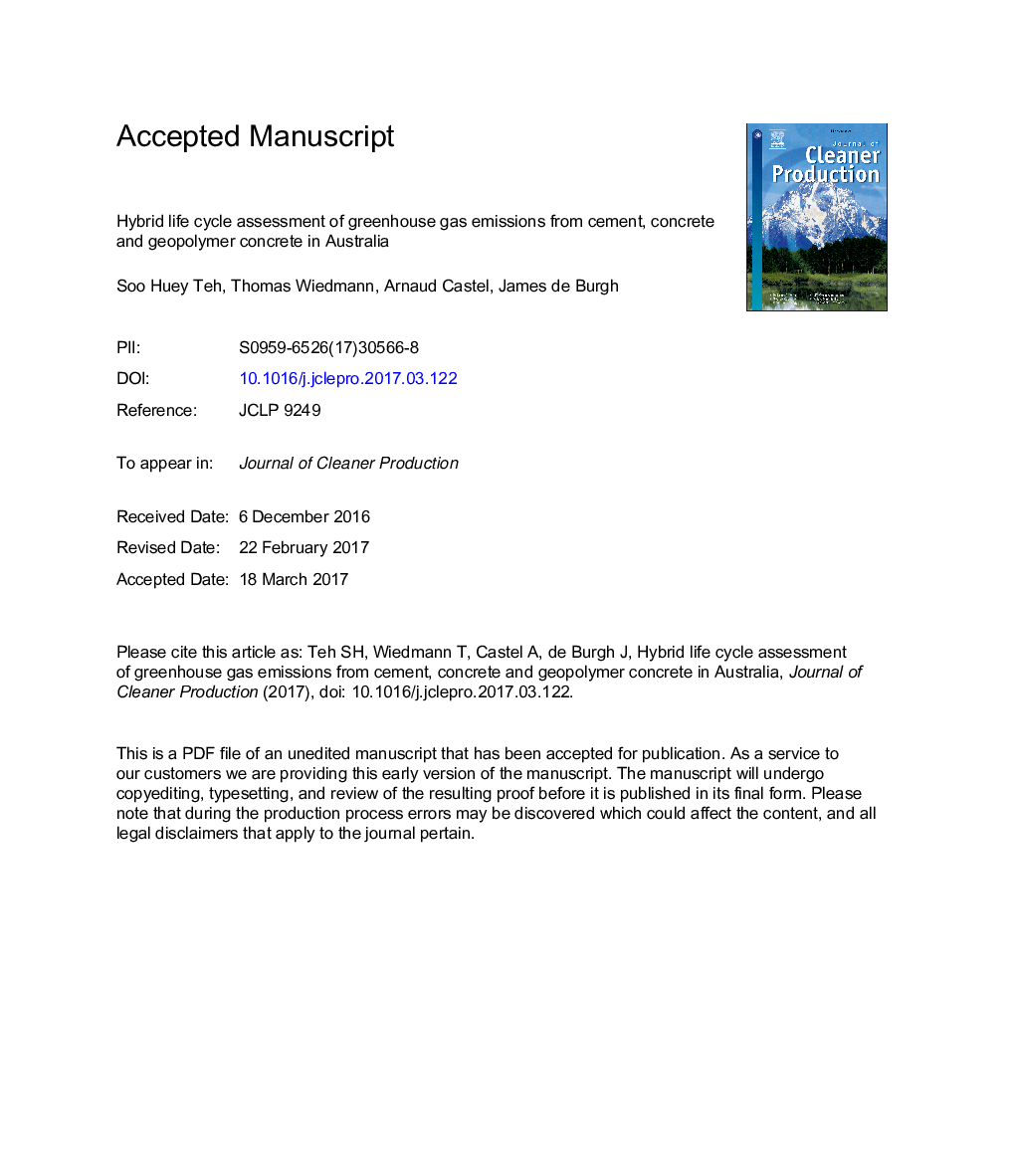| کد مقاله | کد نشریه | سال انتشار | مقاله انگلیسی | نسخه تمام متن |
|---|---|---|---|---|
| 5481302 | 1522101 | 2017 | 36 صفحه PDF | دانلود رایگان |
عنوان انگلیسی مقاله ISI
Hybrid life cycle assessment of greenhouse gas emissions from cement, concrete and geopolymer concrete in Australia
ترجمه فارسی عنوان
ارزیابی چرخه عمر ترکیبی از انتشار گازهای گلخانه ای از سیمان، بتن و بتن ژئوپلیمر در استرالیا
دانلود مقاله + سفارش ترجمه
دانلود مقاله ISI انگلیسی
رایگان برای ایرانیان
کلمات کلیدی
ترجمه چکیده
بتن دومین ماده استفاده شده پس از آب است و تولید سیمان مسئول 5-8٪ از انتشار جهانی دی اکسید کربن است. توسعه بتن های کم کربن در سراسر جهان برای کمک به صنعت ساخت و ساز کمک می کند تا از بین بردن محیط زیست محیط زیست و رسیدن به اهداف کاهش کربن موافقت شده در موافقت نامه پیمان آب و هوا. با این حال، عدم اطمینان در مورد مقدار واقعی از انتشار گازهای گلخانه ای وجود دارد که می تواند با استفاده از انواع دیگری از بتن جلوگیری شود. در این تحقیق میزان شدت کربن تولید سیمان و بتن استرالیا، از جمله سیمان پرتلند معمولی، بتن معمولی معمولی پورتلند، بتن سفارشی معمولی، مخلوط بتن مبتنی بر سیمان و تولید بتن ژئوپلیمر، اندازه گیری می شود. برای اولین بار، روش ارزیابی چرخه ترکیبی مبتنی بر ورودی / خروجی برای این محصولات استفاده می شود. بنابراین هدف اصلی این مقاله، ایجاد یک مقایسه روش شناختی بین ارزیابی چرخه عمر و فرآیند ترکیبی با استفاده از تولید سیمان و بتن استرالیا به عنوان یک مطالعه موردی است. مقایسه با نتایج منتشر شده از موجودی چرخه عمر مبتنی بر فرآیند و تجزیه نتایج به دسته های محصول ارائه شده است. ارزیابی چرخه عمر ترکیبی باعث شد که انتشار گازهای گلخانه ای بالاتر برای سیمان پرتلند معمولی و انواع بتن به علت روش شناسی حاوی یک مرز سیستم اقتصادی در نظر گرفته شود که شامل انتشارات از فرایندهای بالادست است. به طور خاص، برای بتن ژئوپلیمر، نتایج نیز وابسته به روش مورد استفاده برای تخصیص انتشار گازهای گلخانه ای از خاکستر و خاکستر بود. یافته های این مطالعه احتمالا به توسعه راهبردها و سیاست هایی که با هدف کاهش تولید گازهای گلخانه ای در صنایع سیمان و بتن می شود، اطلاع می دهد.
موضوعات مرتبط
مهندسی و علوم پایه
مهندسی انرژی
انرژی های تجدید پذیر، توسعه پایدار و محیط زیست
چکیده انگلیسی
Concrete is the second most used material after water and the production of cement is responsible for 5-8% of global carbon dioxide emissions. The development of low-carbon concretes is pursued worldwide to help the construction industry make its contribution to decarbonising the built environment and achieving carbon reduction targets agreed under the Paris Climate Agreement. However, there is uncertainty around the actual amount of greenhouse gas emissions that can be avoided by employing alternative types of concrete. This study quantifies the carbon footprint intensities of Australian cement and concrete production, including ordinary Portland cement, standard ordinary Portland cement concrete, blended cement-based concrete and geopolymer concrete production. For the first time, an input-output based hybrid life-cycle assessment method is used for these products. The main goal of this paper is therefore to make a methodological comparison between process-based and hybrid life cycle assessment using the Australian cement and concrete production as a case study. A comparison with published results from process-based life-cycle inventories as well as a decomposition of results into product categories is provided. The hybrid life cycle assessment resulted in higher greenhouse gas emissions for ordinary Portland cement and all types of concrete due to the methodology incorporating an economy-wide system boundary, which includes the emissions from upstream processes. For geopolymer concrete in particular, the results were also dependent on the method applied for allocating greenhouse gas emissions from fly ash and slag. The findings from this study are likely to inform the development of strategies and policies aimed at greenhouse gas reduction in the cement and concrete industries.
ناشر
Database: Elsevier - ScienceDirect (ساینس دایرکت)
Journal: Journal of Cleaner Production - Volume 152, 20 May 2017, Pages 312-320
Journal: Journal of Cleaner Production - Volume 152, 20 May 2017, Pages 312-320
نویسندگان
Soo Huey Teh, Thomas Wiedmann, Arnaud Castel, James de Burgh,
